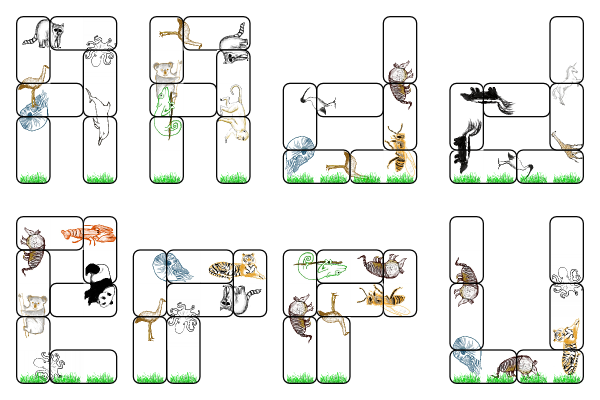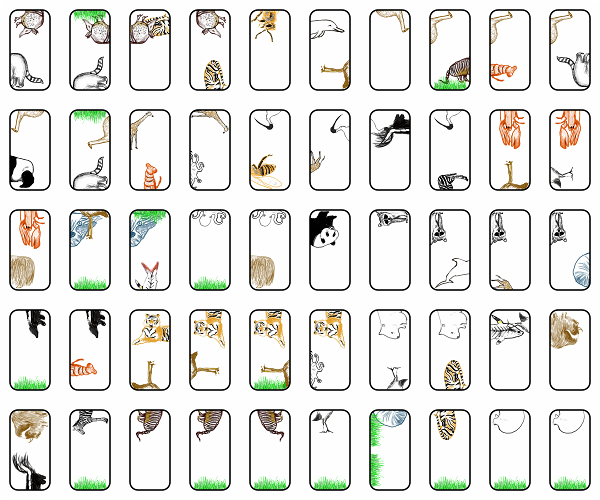
CiSRA Puzzle Competition 2013 - Solutions
1E. Animal Halves
The first step is to cut out the dominoes and make them fit together. Some go together quite easily: the giraffe, unicorn, and two skunks can only fit together one way, and the ibis's head and tail are both lying in the grass to form a lower-case letter "d". From this and the emu, octopus, and aardvark that are also lying in the grass we can deduce that the grass is intended to be the base of each set of dominoes, which are likely to form letter shapes.
The remaining animal pairs can be fit with the assumption of grass at the base, and by ensuring the orientations of the animal halves match (the octopus requires close inspection). The result is:

The letters AAdderrU are formed.
For the next step we need a further insight. The animal dominoes are initially ordered with all the animal heads in the top halves, and with like-animals adjacent. Perhaps the animals are relevant. They are, in order as presented:
- Armadillo
- Bee
- Chameleon
- Dolphin
- Emu
- Giraffe
- Ibis
- Koala
- Lobster
- Monkey (or Macaque)
- Nautilus
- Octopus
- Panda
- Raccoon
- Skunk
- Tiger
- Unicorn
The animals are presented sorted in alphabetical order by head and then tail (excepting one mistake: the emu/nautilus tile is presented after the two emu/raccoon tiles - see the puzzle design notes below). This should help resolve any unidentified or ambiguous animals.
If we write out the initials of the animals for each giant letter in order, starting with the rearmost animal of each and tracing around the letter shape, we get:
| A | NEROD |
| A | CKERM |
| D | INEBA |
| D | SSIGU |
| E | OKALP |
| R | ENTRO |
| R | ACABE |
| U | ANATO |
The next insight is to realise that these letter sequences, like the initial tiles, are also made up of two animal halves, one tail half (the second half of an animal word) and one head half (the first half of an animal word). Arranging them to form animal names in this way, we get two disjoint sets:
A R E R NEROD ENTRO OKALP ACABE = NE RODENT ROOK ALPACA BE
and
A D D U CKERM INEBA SSIGU ANATO = CK ERMINE BASS IGUANA TO
There are six complete animal names, but the leftover letters don't appear to join to make animals. (BECK and TONE could complete the loop but, aside from being English words, they are not thematically compelling.)
The next insight is to realise that we have not yet used the giant letter shapes formed by the dominoes at all! These form two strings of letters, and they are now ordered by the ordering of the strings formed by the animal initials. If we split the two sets of four letters into halves, we get: AR-ER, and AD-DU. These can be used to complete the loops to make animals at all four ends:
ERNE RODENT ROOK ALPACA BEAR
and
DUCK ERMINE BASS IGUANA TOAD
The next step is recursive: once again take the initials of these new animals to get two more ordered sets of letters:
ERRAB DEBIT
One might expect that these sequences also form sets of animal halves. There is no canonical start and end point for these letter sequences, however, as they form a loop. (One might guess that either the first "tail" half of each giant letter or the second "head" half would be the first letter. Unfortunately it was not possible to construct the puzzle this way.) Fortunately, the strings are short enough to observe that the halves can be split and rejoined as two common animals: RABBIT DEER.
The famous mythological half rabbit, half deer is the JACKALOPE, which is the answer.
Puzzle design notes:
We only noticed the error in the alphabetical ordering during the competition when one team e-mailed about it. We considered issuing a correction, but decided that changing the ordering of the tiles might make some teams think the initial ordering was far more important than it really was. The reason for ordering them alphabetically, in puzzle design terms, is to show that the original ordering is unconstrained by the solving steps and could have been completely arbitrary, but we chose to present them alphabetically to give hints of the correct intended names of the animals. The problem with issuing a correction would have been that either we would need to explain this explicitly, which would give away more information about how to solve the puzzle than we wanted to, or else risk confusing some teams and sending them down a nasty red herring path. Since by this stage several teams had solved the puzzle without noticing or reporting the error, we chose not to correct it.
This puzzle went through several painful iterations. The first version encoded LION + EAGLE = GRIFFON, but was nigglingly unsatisfying because the two halves ONEAG and LELI were uneven lengths, had rather awkward intermediate animal words, and resulted in an embarrassing attempt to draw an X-ray fish. Extensive discussion with Geoff Bailey led to the final version. I am very grateful for his collaboration.
I include the previous version for comparison. (It was also much more annoying to cut out with scissors - another thing changed in the presentation with test solver feedback. Consider that a puzzle design principle: Don't annoy the solvers unnecessarily.)
